How to cater to last-minute shoppers this holiday season
As the busy holiday season approaches, a unique customer segment emerges - the last-minute shoppers. They're anxious and stressed and struggle with the ongoing challenge of making swift decisions within a limited timeframe. As an online retailer, you can become a convenient and efficient solution for last-minute shoppers by offering a smoother and less stressful shopping experience.
Last-minute shopping is a tale as old as time. As the end of the year approaches, many consumers find their calendars full of visits to Santa, parties, school holidays and other festivities, making it hard to find time for shopping. Gift-giving can be stressful and humans tend to procrastinate, especially during times of high anxiety or stress. There’s also a subset of bargain hunters that will do anything for deals, even if it means waiting until the literal last minute. It’s not a small group either - over 35% of consumers finalised their holiday shopping on Christmas Eve last year. That’s a substantial market segment that you could be targeting over the holidays.
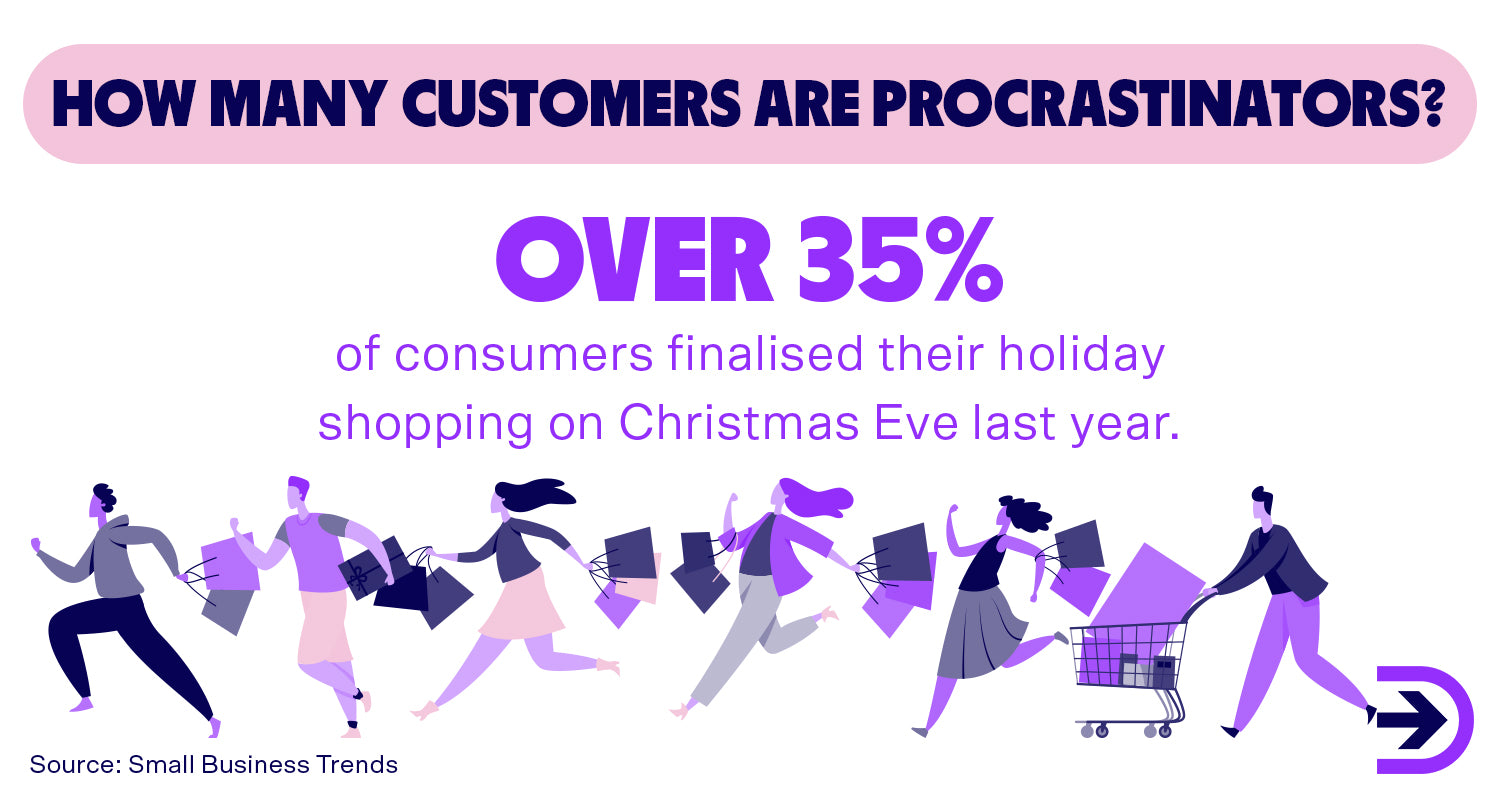
Read on to explore how you can target this lucrative seasonal market and how Dropshipzone can help grow your business just in time for the end-of-year rush.
Understanding last-minute shopper behaviour
Ever wondered what goes on in the minds of last-minute shoppers? It’s impromptu decisions, unexpected choices, and the adrenaline-fueled rush for those eleventh-hour deals. There are many reasons why consumers leave holiday shopping to the last minute. Let’s deep dive into the psyche of these spontaneous shoppers, unravelling the psychology behind their procrastination and uncovering the reasons that drive their last-minute shopping habits.
Scheduling conflicts
The end of the year is a busy time for almost everyone. Whether you work as an office manager, a bartender or a stay-at-home parent, you’ll be dealing with last-minute parties, handovers, holiday plans, graduations, and more. Sometimes, there just aren't enough hours in the day.
Procrastination
Procrastination is the act of delaying or postponing something even though you know you need to get it done. Procrastination can occur when people are stressed, overwhelmed or indecisive. For many, gift shopping is a stressful experience, and they would rather put it off until the last moment.
Waiting for last-minute deals
Along with the holidays come holiday deals, and shoppers are eager to save money on high-ticket gifts. Australian consumers spent roughly $7 billion over Black Friday in 2022, and it’s expected they will spend the same this year with 60% of surveyed respondents planning to make a purchase during the sales. While Black Friday and Cyber Monday typically fall on the first Friday/Monday after the American holiday, i.e. Thanksgiving, many retailers are choosing to start sales early and extend them into the following week. Some consumers will even wait until Boxing Day!
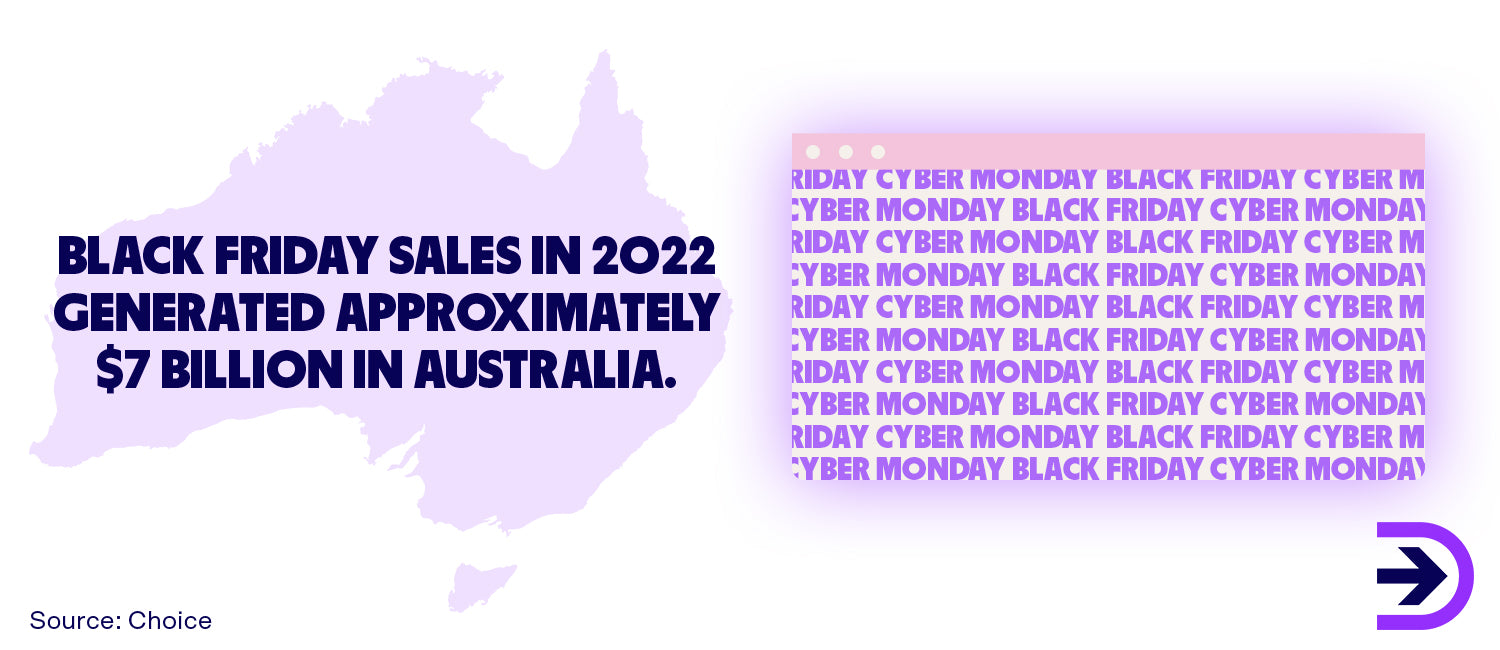
Benefits of targeting last-minute shoppers
Targeting last-minute shoppers can be a strategic game-changer for your business. Catering to their impulsive shopping behaviours offers several benefits. It has the potential to take your business to unprecedented heights. Let’s explore the advantages and opportunities that embracing the last-minute shopper can bring to your dropshipping business.
Increased order value from impulse spending
During the holiday season, 1 in 3 purchases are made on impulse. Gen Z is the most likely demographic to impulse spend, followed by millennials. Free shipping is a key motivating factor for impulse spending, with 50 per cent of consumers convinced to buy something online for free shipping (compared to only 39 per cent of consumers who were convinced by discounts). Buy Now, Pay Later options also encourage 4.9 per cent of buyers to make a purchase. By tempting last-minute shoppers with exclusive deals, recommended products and flexible payment options, you’ll increase your average order value and maximise profit over the holidays.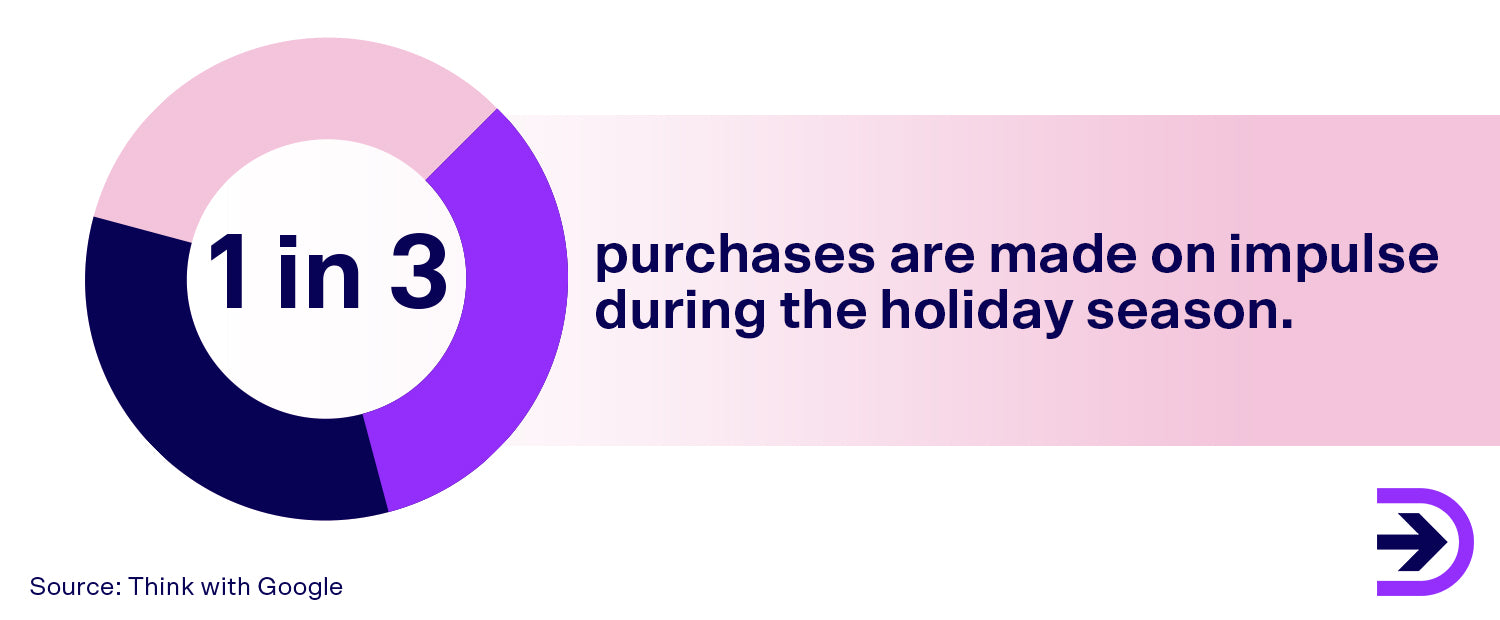
Tap into a new target demographic
In the past, last-minute shoppers have been overlooked. This is because it is harder to foster brand loyalty: last-minute shoppers will buy what they need once, and then leave. However, retailers shouldn’t ignore such a large demographic. Over half of holiday shoppers plan to finish their shopping in December - that’s a lot of potential holiday sales for your store. Despite many consumers starting holiday shopping early, last-minute shoppers will always be there. Additionally, it’s never been easier to remarket to shoppers once the holidays are over. There are many automation tools available to send personalised marketing messages to consumers after they’ve made a purchase, to recover abandoned carts, or tempt back customers who just visited your store. You can read more about these handy tools in our blog “Best Dropshipping Tools in 2023 For Business Growth”.
Not just for Christmas
The end-of-year holidays are obviously profitable for retailers, but there are plenty of other holidays throughout the year that attract last-minute shoppers. 46 per cent of Valentine’s Day shoppers wait until the last minute (two weeks or less before the holiday) to buy a gift. Savvy shoppers often wait until the end of October to buy Halloween candy at a discount. Australia Day is the most popular day for hosting a BBQ, which means a lot of last-minute shopping for food, ice, gas and more. There are also milestone events like birthdays, anniversaries, graduations, baby showers and weddings. No matter the occasion, there is a last-minute shopper in need of a gift, outfit or decoration.
How to seize last-minute opportunities
Last-minute shoppers are not interested in last-minute marketing. If you aren’t at the forefront of their minds when they start searching, you’re not going to attract their clicks. To attract these shoppers, you’ll need to predict their needs and deliver solutions before they know they want them. Here are some of the ways to prepare your online business for the last-minute shopper.
Start planning early
Some retailers believe that planning for the holiday season begins as soon as the previous season is over. Ideally, you’ll have received plenty of data to compare with the previous year and inform your decisions for the coming year. While it’s still fresh in your mind, you can use this data to shape your upcoming marketing campaigns, troubleshoot your supply chain, and improve your customer service processes.
Six months before the holiday season, you should be planning what kinds of products you want to highlight and holiday-proofing your stock levels and shipping times. This might mean using multiple suppliers and courier services to get gifts into the hands of customers. By reinforcing your supply chain early, you’ll outcompete retailers that keep customers in the dark and increase your brand reputation, making it more likely your last-minute shoppers will become loyal customers.
Sell on social media
As trust in online shopping grows, consumers are more likely to not only buy online, but through social media. In a 2022 survey by Statista, approximately 34 per cent of shoppers planned to use social media for holiday gift shopping, and the number of social shoppers was predicted to reach 100 million in 2023. The leading platform is Instagram, with 92 per cent of online retailers using the platform as part of their social commerce strategy.
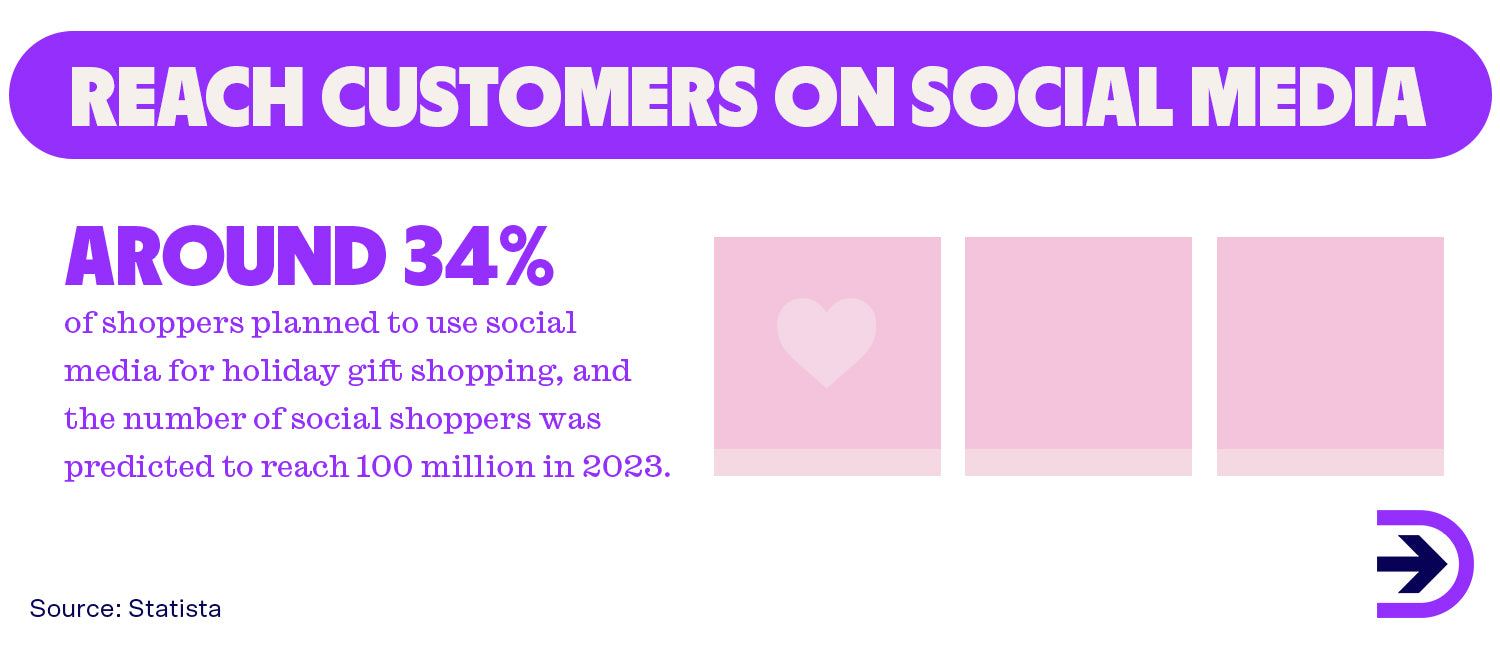
By posting regularly to your social media feed, you’ll meet your potential customers right where they need you to be. By enabling social commerce capabilities, you’ll provide them with a quick solution to their gift-giving woes.
Don’t forget to take advantage of influencer marketing at this time of year. Influencers can expand your brand reach, help your brand feel more authentic, and provide unique insights into your target audience through engagement and feedback.
Appeal to FOMO
Fear of Missing Out (FOMO) is a powerful motivator. It is a type of anxiety that occurs when you believe something positive, exciting or interesting is happening without you. Millennials are particularly susceptible, with 60 per cent of millennial consumers admitting they have made reactive purchases within 24 hours of experiencing FOMO. It can also increase email open rates by 22 per cent and ad click-through rates by 14 per cent.
There are many different ways you can use FOMO in your holiday marketing strategy:
-
Make a limited-time offer with a countdown timer. This creates scarcity, which increases the perceived value of your product. Research shows that just the presence of a countdown timer can increase conversions by 8.6 per cent.
-
Use recent sales pop-ups on your website to show what customers are buying from your site in real time.
-
Advertise exclusive deals in exchange for mailing list sign-ups.
-
Create knowledge gaps in your content. You can achieve this by asking a question or hinting at a secret. For example: “The kitchen gadget professional chefs don’t want you to see!”
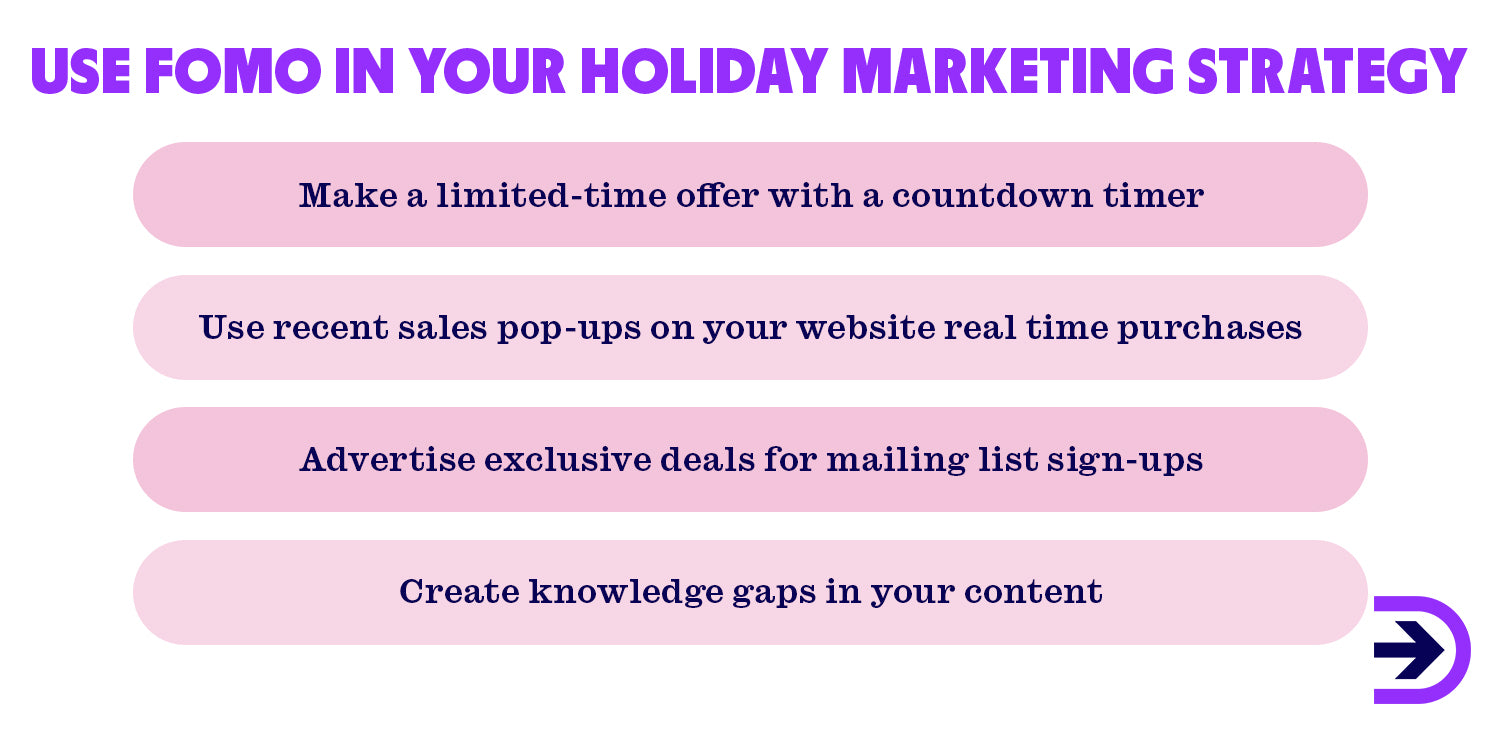
Create gift guides
Last-minute shoppers often procrastinate because they don’t know what to get their loved ones. Make it easy for them to find the perfect present with a gift guide. These guides can help customers come up with unique gift ideas, or help them choose a product that aligns with the recipient’s interests. Your guides might be categorised by:
-
Age or gender: gifts for men, women and children.
-
Occupation: gifts for doctors, teachers, or managers.
-
Interest: gifts for tech lovers, pet lovers, or music lovers.
Your gift guide may consist of individual products, or you could offer a special deal on a bundle of complementary products. Directly link to product pages so that customers can quickly and easily order from your guide. Make sure you also include your shipping policy to assure customers their gifts will arrive just in time.
Upsell/cross-sell at checkout
Upselling and cross-selling are both sales techniques that convince customers to spend more than they had initially planned on a purchase. They might buy a more expensive version of their desired product (upselling) or they may buy a bundle of related products (cross-selling). You may have seen this technique on Amazon, where they not only display similar products on a single product page but also show products that are frequently bought together. They make it simple to add multiple products to customers’ shopping carts. Thankfully, you don’t need to be a master coder to add this functionality to your store. If you sell on Shopify, you can use the app store to find useful tools such as the Frequently Bought Together app, which uses AI to produce automatic, optimised bundles for your customers. For other platforms, there is a wide range of ecommerce tools available with varying levels of integration.
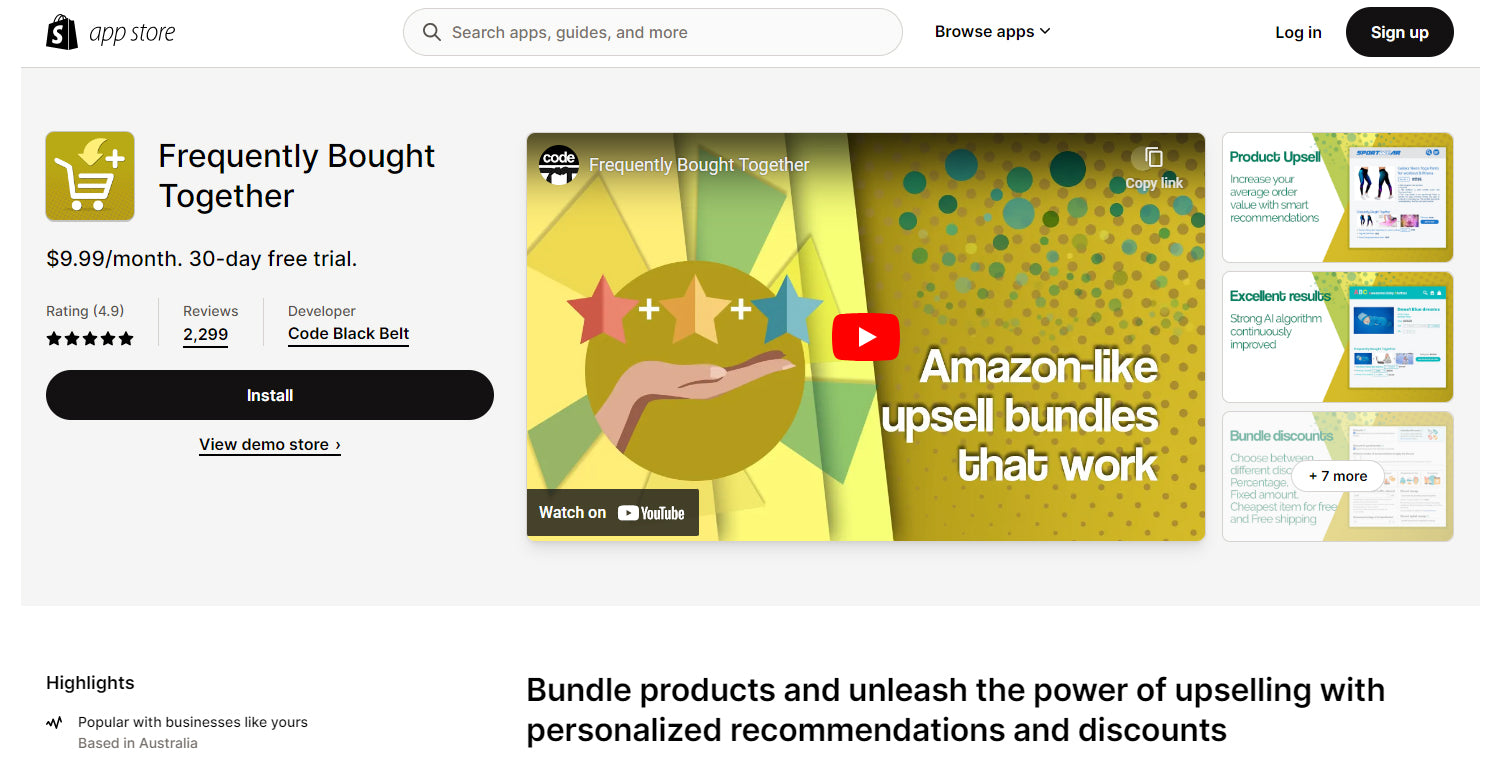
Offer reliable, expedited and/or free shipping
Nobody wants to wait for their gifts, least of all last-minute shoppers. 77 per cent of customers state that they have abandoned online purchases due to unsatisfactory shipping options, and despite many retailers considering two-day delivery as a premium service, a vast majority of customers consider 2-3 day delivery as standard. This becomes difficult during the holiday season when issues such as extreme weather, traffic congestion and other supply chain delays significantly affect delivery times. The fear of high delivery times and shortages causes 36 per cent of customers to start shopping early in the holiday season. For those who don’t, expedited shipping is the perfect solution.
Free shipping is another way to attract customers, especially last-minute shoppers looking for a bargain. Free shipping promotions have a significant impact on 75 per cent of global customers, and 84 per cent of online shoppers will put additional items in their cart to qualify for free shipping. Additionally, 87 per cent of customers are willing to wait longer (up to 7 days) for free shipping. If you cannot offer expedited shipping, cutting shipping fees may be an attractive alternative.
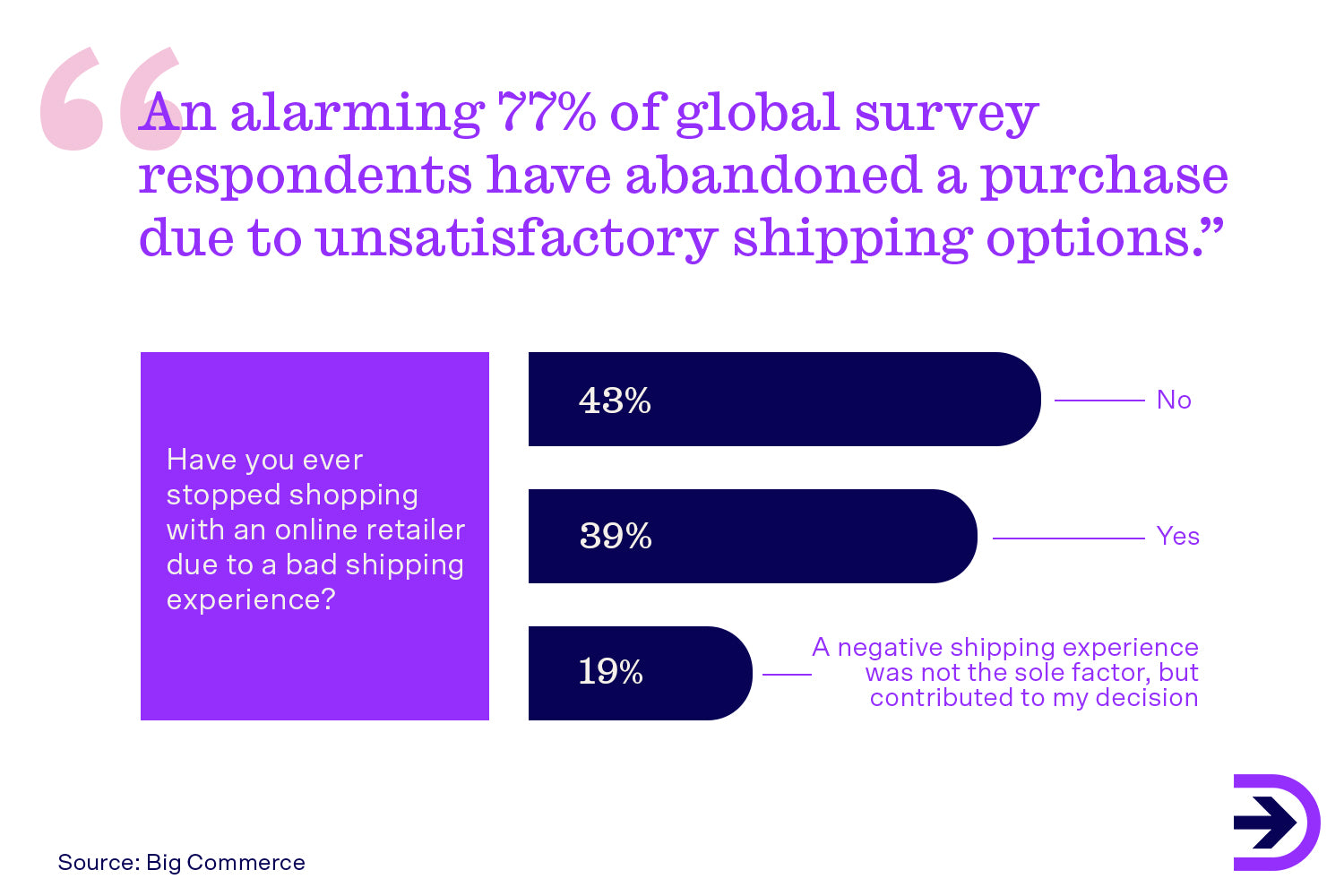
While premium and free shipping can be expensive for businesses, there are many ways you can offset shipping costs. You can view them in our blog “How to Apply the Free Shipping Model: All You Need To Know”.
Leverage email marketing
Email marketing remains one of the most effective communication strategies, with nearly 22 per cent of all email campaigns opened within the first hour of sending and an average ROI of $36 per $1 spent. Thanks to automation tools like Mailchimp and Klaviyo, you don’t need to spend hundreds of hours on personalised email campaigns either - simply set your parameters and let the software do the work. You can send targeted emails using market segmentation, set up abandoned cart automation workflows, send welcome emails with special holiday discounts, and use fun holiday themes for eye-catching promotions.
Clarify your returns policy
In December 2022, 16 per cent of all orders processed were returns, and it is predicted return rates will be even higher in 2023 as customers become more conscious of discretionary spending. Having a clear, simple returns process is important to build trust with customers, especially when you consider that 67 per cent of customers will check a store’s returns policy before making a purchase, and 92 per cent of consumers will return to online businesses with an easy returns policy. A clear returns policy shows that you care about the customer experience and stand by the quality of your products, which can help alleviate consumer anxiety during the stressful holiday period.
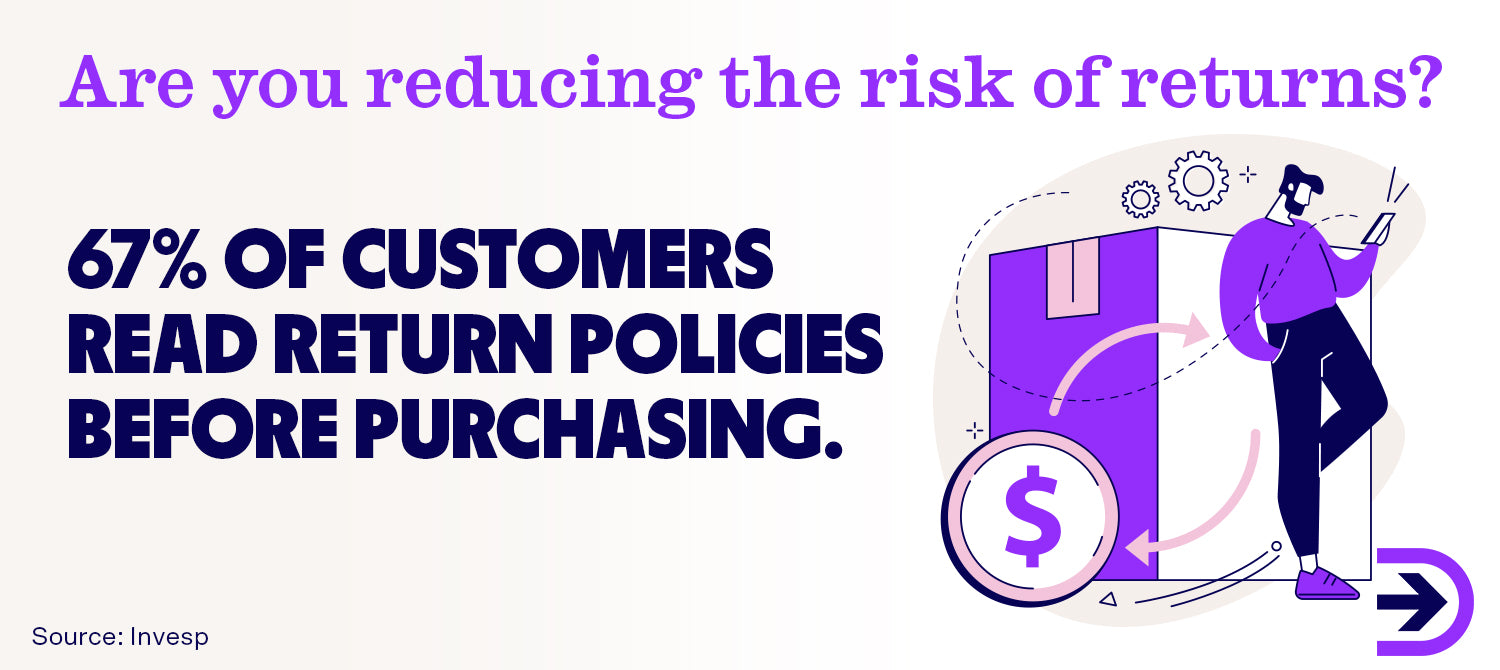
How to prepare your store for last-minute shoppers
Is your online store in a ship-shape? The busy season is a test for most online retailers, as it can expose issues with site performance, UX design, accessibility and more. To ensure your website is fully functional this holiday season, consider the following areas for improvement.
Optimise your site performance
Just like traffic jams in the real world, online traffic sometimes comes to a standstill over the holidays. If too many people are trying to use your online store at once it may lead to slow loading times or crashes. If your site crashes during a big promotion event, you could lose hundreds of dollars in sales. 91 per cent of enterprises report that site downtime costs exceed $300,000 per hour, while 46 per cent of customers will stop shopping with a retailer if their app crashes on Black Friday. Traffic on Black Friday and Cyber Monday can be 15-20 times higher than regular web traffic, so you need to make sure your site is optimised for the rush of customers. You can assess your website using tools such as Google Analytics, PageSpeed Insights and Hotjar. Shopify users can also find useful apps for optimisation from the Shopify App Store.
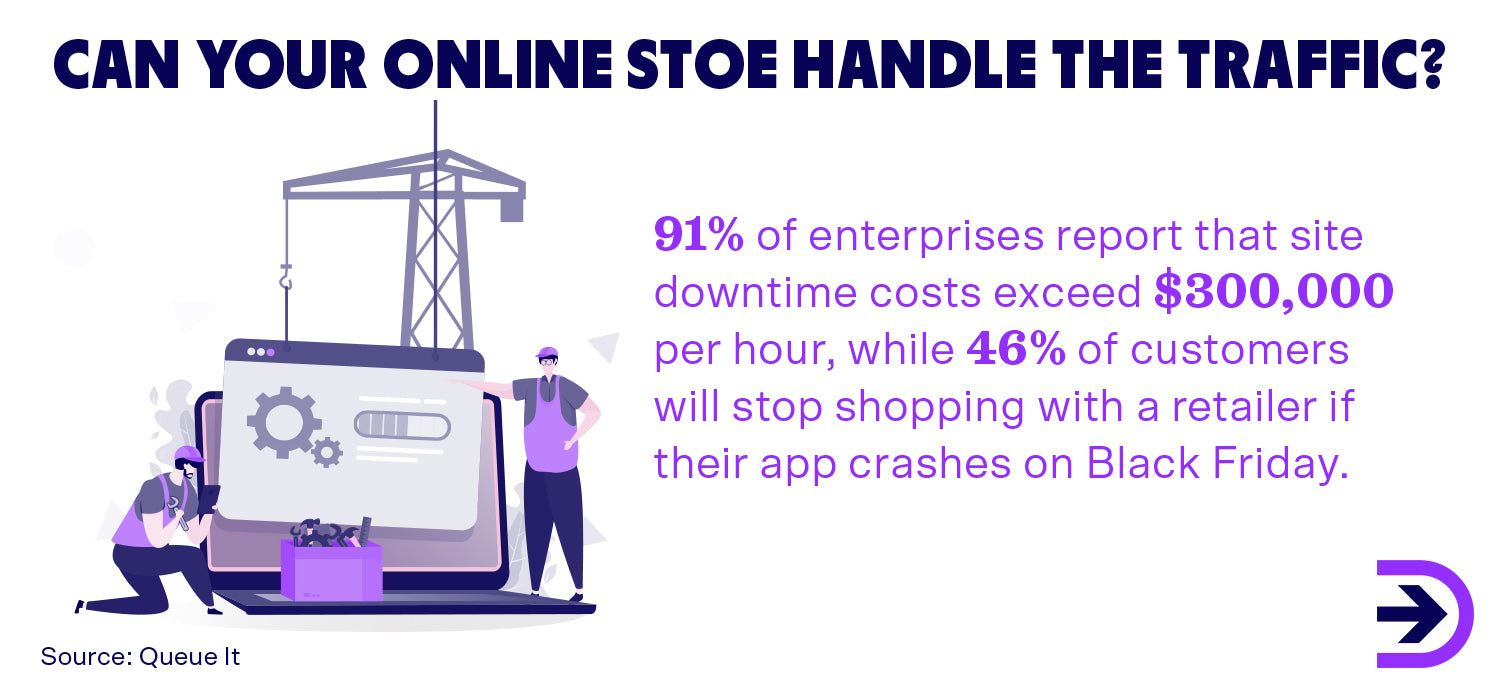
Optimise for mobile first
Consumers are moving away from their desktops and onto their phones to purchase products. According to Statista, mobile ecommerce now makes up about 60 per cent of ecommerce sales worldwide. They’re not the only ones making the switch, with Google fully switching to mobile-first indexing in March 2021. This means that Google prioritises indexing the mobile version of your website, which informs your Google rank. If your site is not optimised for mobile, not only will you turn away customers using your mobile site, but you might not be showing up in Google searches. For other ways to improve your ranking on search engines, check out our blog “How to Use SEM and SEO to Grow Your Ecommerce Business”.
Streamline the checkout process
A long checkout process turns off last-minute and regular customers alike. When a customer is in a hurry, a streamlined checkout process is essential. A slow and complicated checkout with multiple steps can lead to frustration, which leads to cart abandonment. A streamlined checkout process should have minimal steps and clear instructions. Instead of requiring a customer to sign up to your website before purchase, offer guest checkout with the option to subscribe post-purchase. Make sure your checkout is optimised for both desktop and mobile. Make it easy to find your FAQs and customer support pages in case customers need assistance. Finally, offer a wide variety of secure payment options, including Buy Now, Pay Later.
Streamline customer support
The customer service experience is incredibly important to your business. While positive customer experiences are an easy way to reduce customer acquisition costs and build brand loyalty, poor customer service can lead to mass exodus, with 89 per cent of customers boycotting at least one company after a bad customer service experience in 2022 and 84 per cent of customers sharing their negative experience with others.

There are plenty of tools available for ecommerce businesses to streamline their customer service. Chatbots are a quick and easy way for customers to get answers to frequently asked questions, while more complex queries can be answered by live chat services. Customer relationship management (CRM) software such as Zendesk can help link customer data across multiple platforms and departments, allowing you to filter tickets to the right customer service agents.
Post-holiday follow-up: turn last-minute shoppers into loyal customers
Many retailers don’t market to last-minute shoppers because they see them as temporary revenue. However, the right marketing can turn these once-a-year shoppers into lifetime brand ambassadors. Turn last-minute shoppers into all-year buyers with these simple strategies.
Offer post-purchase support, discounts and promotions
The holiday season is over, but your sales potential is not. It’s time to turn these last-minute shoppers into full-time brand loyalists.
The post-purchase customer experience can solidify a customer’s positive experience with your brand. You might send a thank-you email with tips and tricks on how to use their new product. You might send a personalised gift guide based on their purchase history. You could even send a customer experience survey and offer an exclusive discount or product for filling it out. You want to let customers know that you appreciate their business and care about their opinions.
Turn last-minute shoppers into dedicated customers through a loyalty program that rewards repeat purchases. You might use a point-based system, offer exclusive promotions or events to members, create a members-only social media group, or offer rewards in exchange for referrals.
Finally, consider extending your promotional period through to the new year. While the season of gift-giving may be over, consumers continue to spend after the holidays. More than half of young consumers say sales and promotions are their main motivators for shopping after Christmas. 27 per cent of shoppers plan to use their Christmas gift cards in the weeks after the holiday, while 58 per cent will use that time to return or exchange unwanted presents. Extending your promotion period gives these customers a reason to come back to your store after the big day.
Request feedback and reviews
Did you know that 95 per cent of prospective customers read online reviews before buying a product, and 49 per cent say they trust online reviews as much as personal recommendations? It may seem obvious why 86 per cent of customers hesitate to purchase from a business with too many negative reviews, but even more consumers (92 per cent) won’t buy from businesses with no reviews at all! If you want to attract new customers, you need to get feedback from your current ones. Encourage customers to share their shopping experience by sending out customer feedback surveys, using interactive polls, conducting customer interviews, or offering rewards or compensation in exchange for reviews.
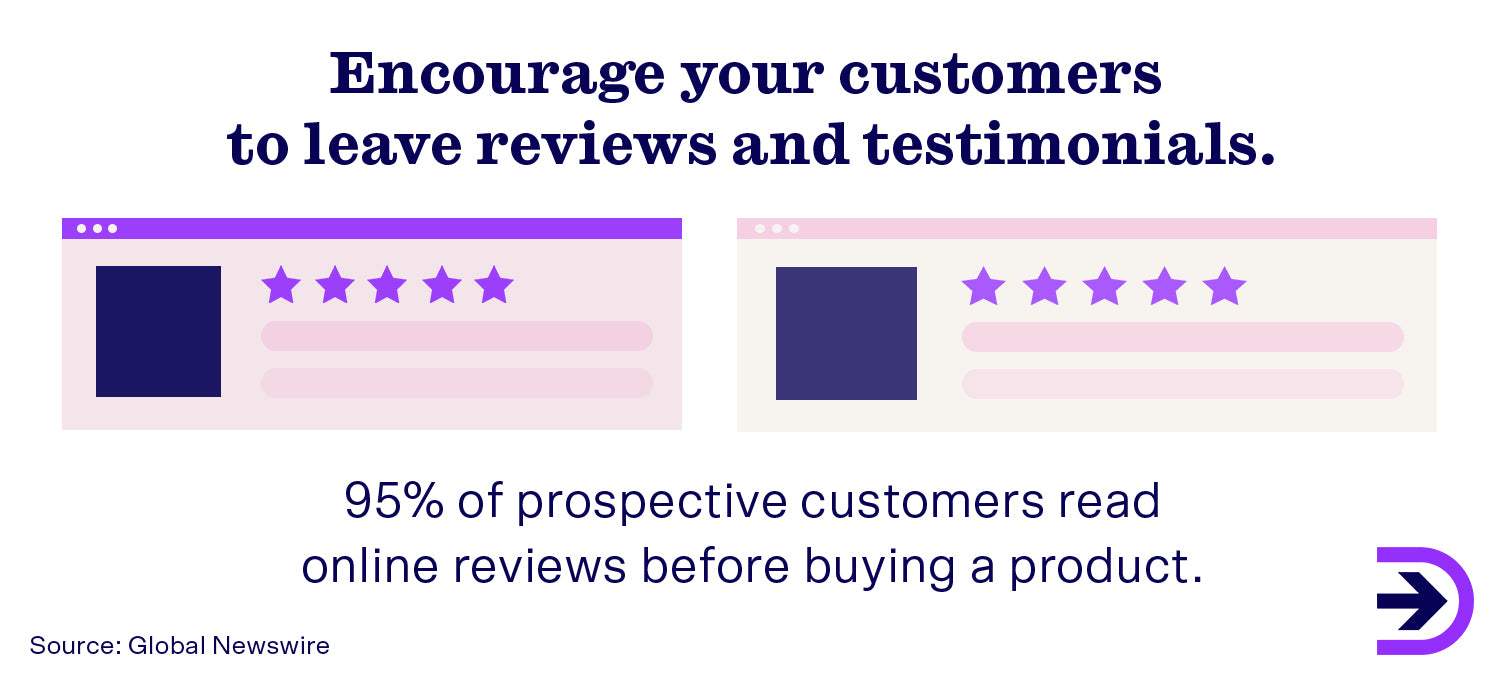
Make sure you respond to feedback promptly. 48 per cent of consumers expect a response to social media questions or complaints within 24 hours. The faster you respond to feedback, the quicker you can solve the issue and the more likely you are to turn an unhappy customer into a return customer.
Social media remarketing
Social media remarketing is a strategy that involves using a social platform to serve tailored ads to a targeted audience of people who have previously visited your website. It is a great way to recapture interest in your brand, attract potential customers, or recapture abandoned shopping carts. Remarketing relies on data collected by cookies, and this data can be used to remind customers about products they viewed, upsell or cross-sell to customers, reach customers who don’t respond to email marketing, and push conversions. Studies show that retargeted website visitors are 43 per cent more likely to convert. You can target specific audience segments based on who visits what pages of your website, how long they spend there and what they interact with. Create personalised campaigns to foster goodwill and encourage brand loyalty. You can employ this strategy on every major social media platform, so you’ll always be able to find your audience.
Last-minute holiday shoppers are not ordinary consumers. They are often stressed, overwhelmed and desperate for a solution. Be their hero during this trying time and you might just find yourself with a new loyal customer base. Earn their trust through excellent customer service, a functional and fast checkout experience and fast, reliable shipping. Stay in their thoughts with personalised retargeting campaigns. With the right approach, you’ll become their one-stop-shop for all their last-minute gifts, all year round.
Dropshipzone has last-minute gifts covered
With thousands of SKUs to choose from, Dropshipzone has last-minute gifts for everyone. You can easily add products to your store from any category, from fashion to electronics. We partner with reliable couriers around Australia to provide you with competitive rates and fast shipping. With no inventory to manage and no minimum order quantities, you’ll never have to worry about overstock. Best of all, Dropshipzone is completely free to join: no hidden fees or subscriptions. Join us today and make ship happen this holiday season.










